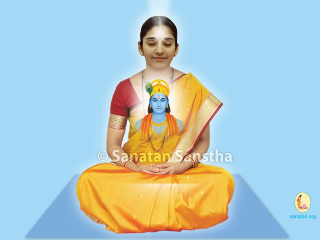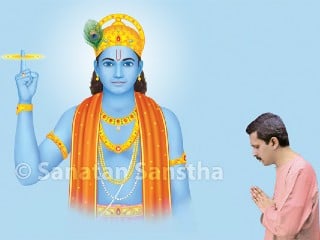An intense awareness about the existence of God or the Guru in any form while carrying out day-to-day life activities is referred to as bhav towards God or the Guru.
Majority of seekers believe that bhav is automatically generated by doing sadhana (Spiritual practice). Although this is not theoretically incorrect, it cannot be guaranteed that this process will occur easily in everyone. This depends upon many factors, such as the objective of undertaking sadhana, intense yearning for God-realisation, centre generated in the subconscious mind about God, actual sadhana which is undertaken, etc. To generate bhav rapidly towards God, it is beneficial to learn how to do it consciously and with curiousness, and put it into practice accordingly. According to the Principle that, ‘Thinking and emotions change the conduct, and vice-versa’, when one constantly performs actions at the level of the mind and intellect, it helps to generate bhav quickly.
In the following article the components of bhav and the importance and types of bhav have been given.
1. Components of bhav
| Components of bhav | Importance (%) | Components of Bhav | Importance (%) |
|---|---|---|---|
| 1. Prayers | 20 | 5. Anand (Bliss) | 30 |
| 2. Gratitude | 10 | 6. Shanti (Peace) | 10 |
| 3. Satseva | 10 | 7. Others | 10 |
| 4. Priti | 10 | Total | 100 |
(Divine Knowledge received by Paratpar Guru (Dr.) Athavale in meditation.)
Of the components of bhav given above, prayers, gratitude, satseva and Priti are the components of sadhana; while the other two components, Anand (Bliss) and Shanti (Peace) are its results. Intellect is not a component of bhav, hence, bhav is always simple. The Anand that one experiences after awakening of the Ashtasattvik bhav or the Shanti one experiences after meditating upon God is because of these components of bhav. For the sustenance and growth of the last two components, it is necessary that the previous components be present in the seeker’s attitude. To have these components in one’s attitude, as per the rule that ‘attitude changes with a change in behaviour’, one should strive at the level of the mind and intellect.
2. Importance of bhav
2 A. Bhav indicates existence of God
न काष्ठे विद्यते देवो न पाषाणे न मृण्मये ।
भावे तु विद्यते देवो तस्माद्भावो हि कारणम् ।।
Meaning : God does not exist in a wooden, stone or mud Idol. He exists in bhav, which is why bhav is important. Saint Eknath says in a verse of His hymn – Explain to me whether God exists where there is bhav or if bhav is present where God is. You only solve this puzzle. Tell me with certainty what is superior – bhav or God. The nature or form of God will be according to the nature of bhav. The greater the bhav, greater will be the spiritual experience of God. If there is no bhav, God’s presence will also cease to exist. That is why, Saint Eknath says with the grace of His Guru Janardanswami, that God exists where there is bhav, that bhav itself is God. If anyone disbelieves this, then he should see what spiritual experience he derives in his antahkaran in this regard.
2 B. Bhav is an assurance of God’s Priti
Saint Tukaram Maharaj says in one of His hymns – A devotee’s duty is to have singular bhav towards God. The true secret of devotion is to have this bhav with a firm resolve constantly. Devotees should have firm faith in God, without expecting anything in return. They should not wish for the support of anyone else. God should be their sole support. Saint Tukaram says that He has not heard of a devotee who has such a bhav and has been ignored by God.
2 C. Result according to the bhav
मंत्रे तीर्थे द्विजे देवे दैवज्ञे भेषजे गुरौ ।
यादृशी भावना यस्य सिद्धिर्भवति तादृशी ।।
– Sri Gurucharitra, Chapter 9, Shloka 48
Meaning : The benefits obtained due to a mantra, a place of pilgrimage, a Bramhan, a Deity, an astrologer, a medicine or a Guru depends upon the bhav one has towards them.
2 D. Bhav towards God
Really speaking, ‘bhav’ cannot be explained in words; in fact it is even beyond all the concepts related to bhav. Once bhav develops, the person constantly remains in communion with God.
3. Types of bhav
-
Stambha (remaining motionless)
-
Swed (sweating)
-
Romanch (bristling of hair on the body)
-
Vaisvarya (tremulous voice)
-
Kampa (tremor)
-
Vaivarnya (becoming pale)
-
Ashrupat (tears flowing)
-
Pralay-cheshtha nirodh (fainting)
Most seekers experience flowing of tears when the ritual of Arati is performed, or when they remember their Guru / God, or recollect different incidents pertaining to them. Of the eight types of bhav, this can be classified as Ashrupat. When all the above eight signs are seen simultaneously, it is said that the Ashtasattvik bhav has been awakened.
4. In whom is bhav awakened ?
The spiritual level of an average individual is 20%, while that of a Saint who has attained Moksha (Final Liberation) is 100%. For sadhana to occur smoothly only because of bhav, the spiritual level of the seeker has to be at least 50%. Similarly, to awaken bhav through sadhana, the minimum spiritual level required is 50%. To attain this level, one needs to do Namjap (chant the Deity’s Name), remain in satsang and perform satseva constantly. Even after awakening of bhav, to maintain it one needs to keep performing sadhana.
Reference : Sanatan Sanstha’s Holy Text on ‘Spiritual Practice for awakening Spiritual Emotion’.


 Vyashti and samashti bhav
Vyashti and samashti bhav Why is it essential for yearning and bhav to be linked for rapid spiritual progress?
Why is it essential for yearning and bhav to be linked for rapid spiritual progress? Efforts to be undertaken to awaken bhav
Efforts to be undertaken to awaken bhav Why is Sharanagatbhav superior to Krutadnyatabhav?
Why is Sharanagatbhav superior to Krutadnyatabhav? Progressing from expressed to unexpressed bhav
Progressing from expressed to unexpressed bhav